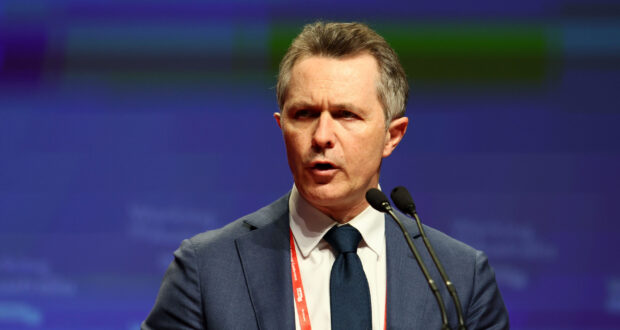The panel of the National School Reform Agreement (NSRA) review released a report on Tuesday that will guide negotiations about the next education reforms.
The NSRA is a bilateral agreement between federal and state and territory governments, where the latter agrees to use taxpayer dollars to enact reforms that the agreement outlines.
Immediately, the report stated before any of its recommendations can be met, each school needs to be government-funded to 100 per cent of their Schooling Resource Standard (SRS), a reform the government agreed to a decade ago.
All education ministers vowed to fix chronic funding shortfalls in public schools in a statement released shortly after the review, but how the cost of closing the funding gap (an estimated $6.6bn) will be shared is still yet to be determined.
Unions have been calling for the federal government to commit to full SRS support as they say currently only 1.3 per cent of public schools are government funded to the full amount.
The SRS, derived from recommendations made by the 2011 Review of Funding for Schooling led by David Gonski, provides an estimate of the public funding required for a school to meet its student’s educational needs.
Currently, the standard’s funding equates to $13,060 for each primary student and $16,413 for secondary students.
Existing legislation restricts the federal government’s contribution to 20 per cent of SRS funding, with state and territory governments to pay the rest for the schools they operate.
The federal government contributes 80 per cent of the SRS to private schools that rely on fees.
A recent independent report commissioned by the Australian Education Union found that chronic underfunding of public schools in every state and territory was on track to worsen over the next five years.
It also found that nationally, private schools were overfunded to the tune of over $800m in 2023, while public schools were hit with a shortfall of $4.5bn.
The union has asked the government to lift contributions from 20 to 25 per cent of the SRS for all states and lift it to 40 per cent for the NT, where student disadvantage is the worst.
Along with implementing measurable student and staff wellbeing, the NSRA review recommended increased transparency about where public funds go, and said that teachers and principals should have more involvement in funding discussions.
Measuring student and teacher wellbeing
Addressing the disparities between advantaged and disadvantaged students, supporting teacher wellbeing, and building a strong workforce are all issues the panel said should be priorities in the next agreement.
They suggested strongly that protocols put in place to address these issues should be consistently measured and analysed to ensure they're making a real difference in schools.
The review outlined how Australian schools are some of the most socially segregated among OECD countries, where affluent and non-affluent students often "grow up strangers" to one another.
Increasing socio-educational diversity is one way to reduce data gaps between advantaged and disadvantaged (including First Nations and disabled) students, the report said, to mitigate the problems caused by concentrated areas of students with varied schooling needs.
One specific area that the panel recommended should be regularly measured is students’ progress in developing fundamental literacy and numeracy skills in year one.
This would ensure disadvantaged students don't get left behind, and were accessing services such as catch-up tutoring.
Monitoring student wellbeing and mental health is another factor the panel said will improve learning outcomes, contributing to higher teacher satisfaction and minimised workloads.
The report stated 'year 7 to 12 students experiencing poor mental health have, on average, more than double the number of absent days and by year 9 are, on average, 1.5 years to 2.8 years behind in literacy and numeracy outcomes. Wellbeing is very much connected with learning, and vice versa.'
The review also said attracting and retaining teachers could be helped by an increase in teacher wellbeing and satisfaction through lessening administrative workloads and 'celebrating the profession'.
The panel, while recommending more leadership training and professional development courses for teachers and principals, was wary off adding to the already overwhelming teacher administration workload, and said only useful and effective additional training should be implemented.
They also said Unique Student Identifier (USI) numbers should be improved to streamline education for students who move between schools often.
In summary, the report recommended three 'pillars' to be used to achieve priority outcomes in the next agreement: equity, wellbeing and workforce; that should:
- Lift student outcomes
- Improve equity
- Improve student wellbeing
- Attract and retain teachers
- Reduce data gaps and limitations
- Enhance funding transparency and accountability
- Support innovation and achieve reform
A new agreement
The current NSRA has been active from 2019 and was due to expire this month, but was extended to December 2024 by Education Minister Jason Clare after his productivity commission claimed little progress had been made on the current agreement by the former government.
The minister said the panel needed this year to review what needs to change in the next agreement to deliver improvements for all students, especially those who are struggling in the education system.
The panel also recommended the next NSRA should be a 10 year agreement with a mid-way review point, to lower the frequency of a sometimes 'constant' change in goals and processes imposed on the teaching workforce.
Dr Lisa O'Brien, chair of the Australian Education Research Organisation (AERO), chaired the panel, along with other education experts, who spoke to schools and education stakeholders to investigate the NSRA.
Do you have an idea for a story?Email [email protected]
 Education Review The latest in education news
Education Review The latest in education news
